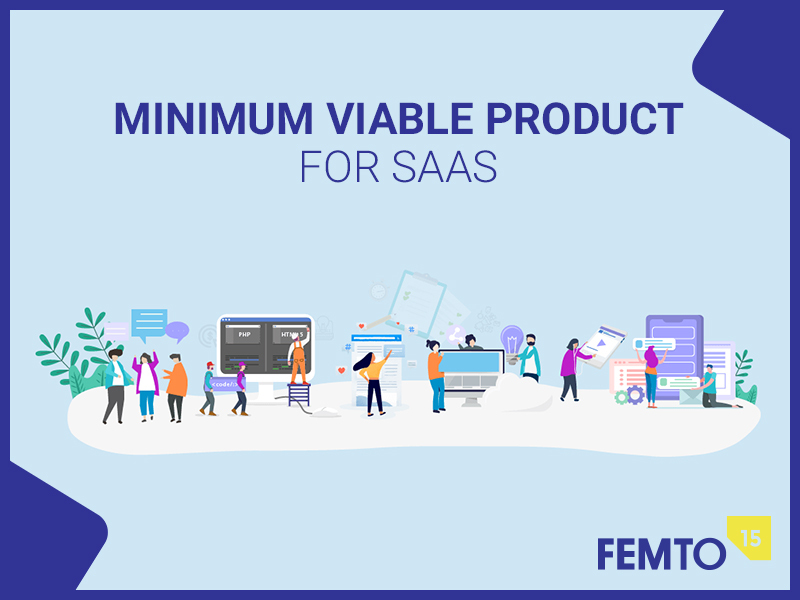
Minimum Viable Product for SaaS
By Femto15 Team - October 1, 2019Software as a service is now the best choice for most passionate entrepreneurs who are eager to start their own business through the web. But implementing software requires various resources just to come to light and then find out whether or not people would accept it with love and pay for it.
The risk that conquers entrepreneurs' hearts may prevent them from starting at all. They get captured into the perfectionism of the final product and the assumptions that may turn wrong, and so lots of ideas die before they born.
That's when lean startup concepts shine to save the day and suggest the idea of minimum viable product or MVP for short. The purpose of a minimum viable product is to apply the build-measure-learn feedback loop, which is the core principle of lean startup. It's a quick way to validate your application without much risk nor time to learn whether or not should you invest more resources into it.
In this article, we give an overview of minimum viable products and illustrate why and how would a startup needs it.
What is a minimum viable product (MVP)?
Eric Ries, the author of The Lean Startup, first defined the minimum viable product as:

So it's a version of your product, but which version?
A minimum viable product is that version that holds only the core features of your product. It should not be perfect, nor should it looks like the final product you have in mind, but it should display a working example enough to absorb the required information. Even if it's manually handled behind the scenes or it doesn't look cool.

Why do you need a minimum viable product for your SaaS?
- How would the market react to your product?
- Would the customers like your product as it is? Or would they prefer to add features and remove others?
- Is your solution really solves the problem as expected? Or not?
- What about the competitors, would customers find your solution better? Why would they?
Lack of information, that's the main problem we face, and the solution is to learn.

In Eric's definition, the purpose of a minimum viable product was to collect the maximum amount of validated learning. So, what is validated learning?
It's defined as the unit of progress for Lean Startups. You build a version, launch it, measure its success using some metrics, collect enough data, analyze that data, and rebuild a new version using the info you got. Each iteration is a unit that is used in the final product.
To sum up the why-question answer we can say that minimum viable product allows you to:
- Test your product in the real market before launching.
- Minimize the resources needed to launch (including the most valuable resource which is time).
- Get early customers of the product.
- Get enough information to analyze your opportunities and risks.
- Minimizing the risk.
- Get customers' feedback about each version of the product.
- Test the route while walking and do some course correction according to customers feedback and market's needs.
- Understand the competition closely.
In short, it's all about learning, testing, and analyzing using the minimum amount of resources.
How do you create a minimum viable product (MVP)?
The purpose of an MVP is to deliver the minimum value that is enough to learn with the least effort. So how to do that?
1. Problem definition
Any product exists to solve a certain problem that faces target customers. Problem definition is an initial state for all coming stages. Through it, you can tell the basic functionality that touches your target customers' pain points.
2. Market research
First of all, you should investigate your customers, get their feedback even before stating your hypothesis about the most important features. Understanding the market prevents you from solving a problem that nobody has or building things that nobody cares about.
The customer is the most important part of the production line.
W. Edwards Deming
3. Define the minimum features
The minimum viable product is that product which has just those features (and no more) that allows you to ship a product that resonates with early adopters; some of whom will pay you money or give you feedback.
Eric Ries
Prioritize your features to put your hands on what you think is critical in your product, then create it.
4. Build a usable version
If you are not embarrassed by the first version of your product, you’ve launched too late.
Reid Hoffman
Deliver something that works, not something that is perfect. Remember that you aren't launching just anything, but the thing necessary to absorb enough information. It should be usable and represents the main porpose of the product.
5. Set measurement metrics
Once the MVP is established, a startup can work on tuning the engine. This will involve measurement and learning and must include actionable metrics that can demonstrate cause and effect question.
Eric Ries
To know how is your product doing, you should define the metrics related to its nature and category. It may be conversion rates, word-of-mouth, or anything that you think shows whether or not you are on the right route.
6. Add more value along the way
After each iteration, you get feedback that helps you add more features related to customers' needs. That way the theory of more features, more value applies, because each new feature you add is driven from customers' feedback.
7. Pivot or make a course correction
At some point, you may figure out you are failing and your idea isn't what people really need. That's okay, it's better now than later. Start over using the data collected from your MVP and provide another solution that holds customers' vision along your own vision.
Final words
Creating a minimum viable product isn't simple. It doesn't mean creating a trivial crap that has nothing to do with your final vision. Rather it's a complicated thing that consists of varies iterations and continuous analyzing to develop the closest product to your customers' needs without wasting time nor effort along the way. Creating a product that is highly associated with the market and minimizing the resources needed to launch is the reason for MVP existence.
ABOUT AUTHOR
Femto15 Team


you may also like
0 comments